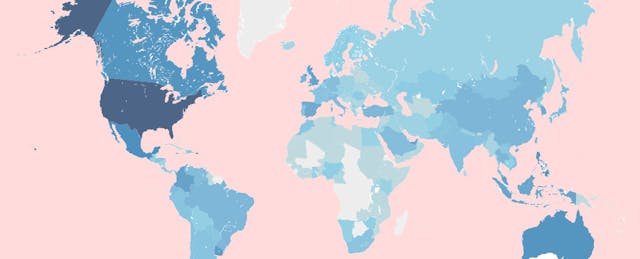Typically, edtech tools that go “viral” have two characteristics: they’re offered directly to consumers, and they’re completely free (for now): Just ask Remind and ClassDojo.
Schoology, however, is bucking this trend with its learning management system (LMS)--a tool that to many might appear to be too complex for fast adoption. See that map below? It shows the tool’s penetration. With over 7.5 million users across 60,000 schools in about 200 countries, this LMS platform is growing across six continents and signing up entire countries as customers.

Take Uruguay for example. After deciding to embark on an ambitious countrywide 1:1 program, rollout leaders selected Schoology this past summer as the chief LMS for the program, meaning that every school in Uruguay is now using the platform on 620,000 laptops.
While CEO Jeremy Friedman insists that the growth is majorly “organic” and due to social media, there are nevertheless specific attributes of Schoology’s platform, customer relations and partnerships that have contributed to this international growth--and most of them have nothing to do with course management or the software itself.
How is Schoology doing it?
People want to connect--so offer them that option
Schoology, founded in 2009, is free for educators, and has a lot of the features typical of an LMS: folders to organize subject material for specific academic units, an online gradebook, quizzes that integrate into coursework, and so on. But Schoology also offers users a way to connect--an “integrated teacher network where people can interact with each other across countries,” Friedman says, similar to tools like Edmodo.
Through this extensive educator network, users can connect over common edtech issues, share best practices and alleviate feelings of isolation. “Having those aspects of social and collaboration is a big thing. You get that even in small rural districts in the U.S., and it’s the same globally,” Friedman shares.
Friedman feels that this network--bolstered by Schoology’s groups, online discussions and publicly-shared, user-created resources--is one of the biggest contributors to its increasing user numbers, and something that newer edtech teacher-facing tools should have. “The trend you're seeing is that people are more connected than they have ever been. That's just a very different mentality than has been there in the past,” he shares.
Address those needs for localization
While Schoology connects educators to each other, Friedman also attributes its success to his team’s ability to localize the tool to adapt to what specific countries and communities need.
For example, Schoology’s platform in currently available in five languages--French, Spanish, Malay, Japanese, and English--and is in the works of translating it and testing it in four more languages. “It would be hard for us to be in Uruguay or Spain if we didn't have a localized platform in their language,” Friedman says.
Additionally, Schoology works both with schools and edtech companies to tailor the platform to user needs. Currently there are roughly 50 apps that can integrate with Schoology out-of-the-box, like Google Apps for Education, PowerSchool and Moodle. It can also integrate with any of the 100+ Learning Tools Interoperability-approved applications (as determined by IMS Global Learning, an edtech nonprofit), including products by ALEKS, Cisco, eLumen, Desire2Learn--even Blackboard.
“We've helped [schools] aggregate a lot of disparate systems, like Turnitin, into a single place,” Friedman shares, adding that he and his team focus on each school, district, or country’s desires for “the day-to-day teaching and learning experience.”
Are those requests different from country to country? Absolutely, Friedman says. So, with the need for localizing products comes a need for partners on the ground, meaning those who can read the needs of the educators and work with Schoology to fill those needs.
Malaysia is a prime example; back in 2010, Schoology partnered with Cempaka Schools in Selangor, Malaysia, which used Schoology in its system of five for-profit, private Malaysian primary and secondary schools. Working with Cempaka gave Schoology the help it needed to grow elsewhere, too, as both organizations “jointly promote[d] increased usage of the Schoology platform in school systems throughout Malaysia and Singapore,” one press release explains.
First comes free, then comes enterprise
More users equals growth, but bringing in revenue is also vital to sustaining as an organization.
Friedman explains that while the “free” offerings (which include access to build content, curriculum, and interact with other users) draw instructors to Schoology, they are just a minor component.
The focus on building a global community while offering localization services both play a key role in getting districts to pay for “enterprise” packages, according to Friedman. It’s the enterprise option that solidifies those relationships with larger schools and districts, and gets the individual users the components they need--aggregated calendars, web hosting, SIS integration--to become a true professional learning community.
“There's a stigma that there's a different set of objectives abroad, but at the end of the day, everyone's trying to help students,” Friedman says.


